|
Gloster Meteor F.8
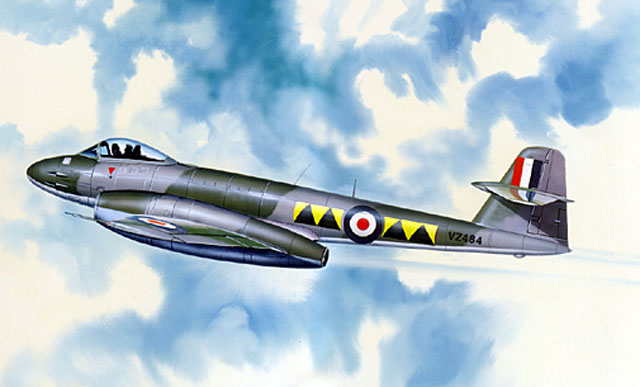
Classic Airframes
Hannants Special Edition
S u m m a r y
|
| Catalogue
Number: |
478 |
| Scale: |
1/48 |
| Contents and Media: |
71 parts in grey styrene; 7 in
clear styrene; 13 parts in dark grey-coloured resin. Decal sheet
with two marking options. 6 pages of instructions and letter-sized
colour marking guide. |
| Price: |
GBP£29.95 (in the European Union)
GBP£25.49 (outside EU) |
| Review Type: |
FirstLook |
| Advantages: |
Important subject with this
variant not previously available as an injection kit in this scale;
beautiful surface detail; accurate outline; thoughtful engineering;
crystal clear transparencies; excellent resin parts; good quality
decals with colourful marking options; useful options - large and
small intakes, belly tank, drop tanks, and two styles of canopy
(canopy option in Hannants edition only); clear instructions |
| Disadvantages: |
No gunsight; some chunky sprue
attachment points; possible problem with style of wheels |
| Recommendation: |
Highly Recommended for
experienced modellers. |
Reviewed by Brett Green
It was not surprising to hear that Classic Airframes was
about to release a model of a British aircraft that had not previously
been available as an injection moulded kit. It was surprising that this
latest subject was going to be a post-war jet.
Classic Airframes' 1/48 scale Meteor F.8 is their first
post-war, jet powered subject. The kit is delivered in familiar packaging
with an attractive painting by Don Greer on the boxtop. The model
comprises 71 parts in pale grey injection moulded styrene, 7 parts in
clear injection moulded plastic, and 13 resin parts.
The quality of the plastic parts is excellent. The surface
texture is satin, and panel lines are finely engraved. The dive brakes on
the upper and lower surfaces of the wings are represented by engraved
panel lines. Most of the ejection pin marks are hidden on the inside
surface of parts except for one big raised pin inside each main wheel
well. The only other minor problem was some disappearing rivet detail on
the inside of one gear door - hardly a tragedy.
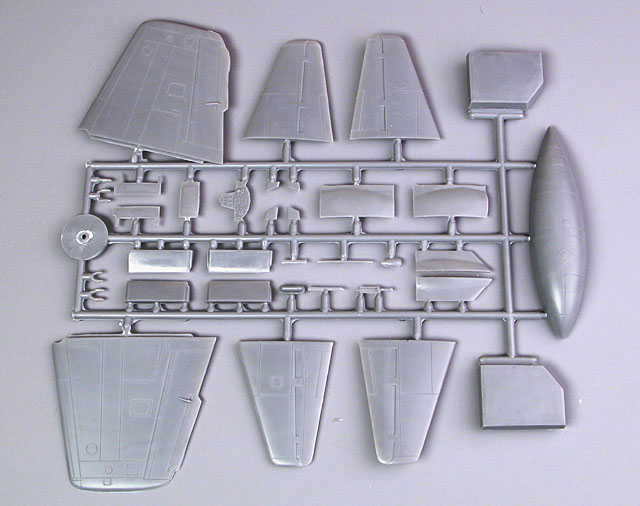
Trailing edges of most flying surfaces are nice and thin,
but the inside surfaces of the rudder halves would benefit from some
sanding. The trailing edge of the wing centre section (inboard of each
nacelle) also seems a trifle thick but a few minutes with a sanding stick
will remedy this area too.
Engineering is thoughtful. The lower centre section of the
wing is moulded as a single part, onto which the inside upper wing parts
(incorporating the nacelles) are joined. The outer wing panels are secured
via a recessed reinforcement strip - much better than the butt-join we
might have otherwise expected.
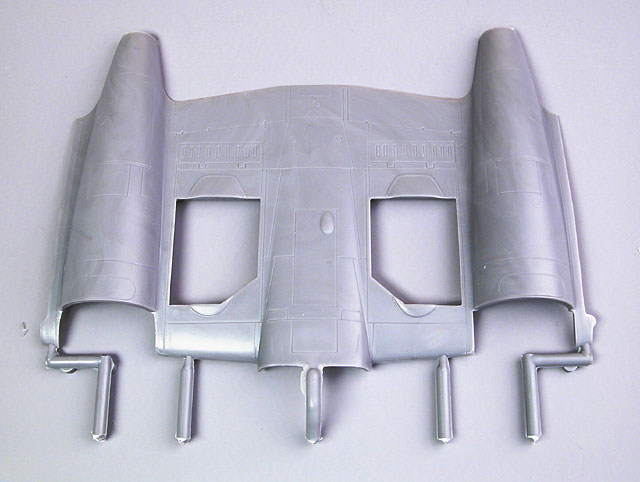
We do get a butt join for the horizontal tailplanes
though, so some reinforcement with wire or fine brass rod would be a good
measure to prevent later damage.
There are no locating pins, so extra time should be
allocated for test-fitting and aligning parts. Also, sprue attachment
points are a little thick and located in some prominent areas, so take
care when removing and cleaning up parts.
We will be seeing other versions of the Meteor later this
year, and the parts breakdown reflects these plans. The forward nacelles
are supplied as separate parts. In fact, Classic Airframes has supplied
both the smaller, early intake and the larger, later intake in all
versions of the kit.
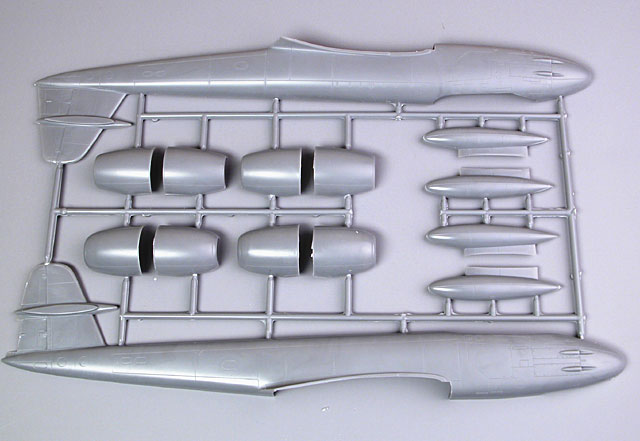
The canopy, navigation lights and landing lights are all
supplied in clear injection-moulded plastic. The parts are very thin and
free of distortion. They also respond exceptionally well to Future. I
dipped some of the parts and the sparkling results speak for themselves -
no prizes for guessing which set of parts was treated!.
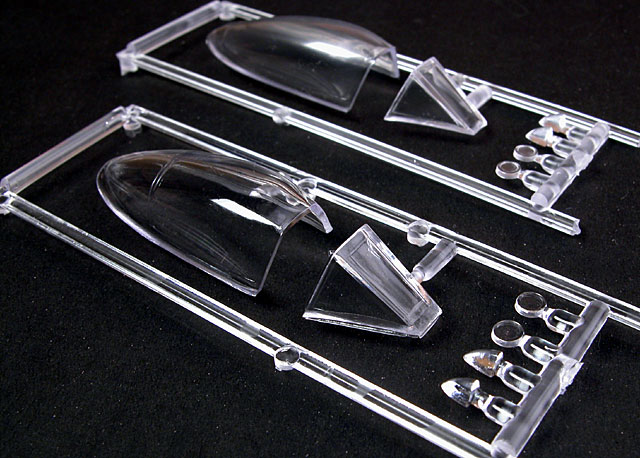
The standard edition of the kit offers the canopy with the
rear metal cover in the Early Version boxing, and the all-clear canopy in
the Late Version boxing. The early version canopy on the real aircraft
featured a very slightly "blown" effect forward of the metal cover. This
is not depicted on the early version kit canopy but, to be fair, it would
be a very small deviation from the flat canopy line in any case.
My review sample is Hannants "Special Edition",
which includes both sets of canopies. The "Late" version decals come with
this kit.
Resin parts are delicately detailed and as nice as we have
come to expect from Classic Airframes in recent years. The complex mount
for the nose wheel is pre-fabricated, saving the modeller some potentially
delicate assembly. Both this part and the combined cockpit floor/nose
wheel well and nicely rendered. I particularly like the Martin Baker Mk.2
seat. Careful painting of the cushions and harnesses will offer the chance
to add some colour to the otherwise all-black cockpit.
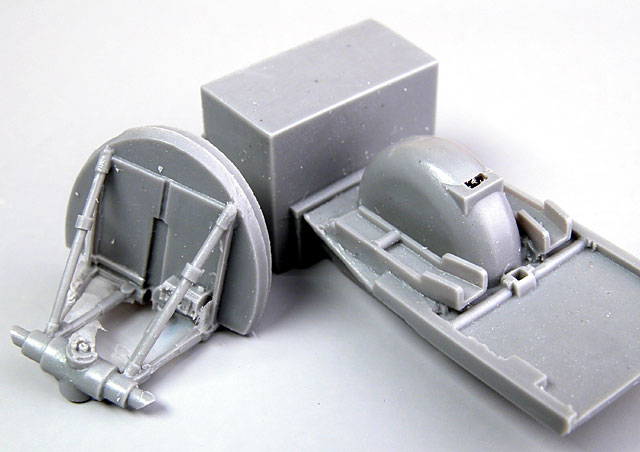
Click the thumbnails below
to view larger images:
Instructions are logically laid out in six pages over 14
steps. Brief notes supplement the exploded view diagrams.
Decals are provided for three aircraft. In the review
sample, these are two RAF aircraft finished in Dark Green and Dark Sea
Grey over Aluminium; and one Israeli Meteor in Tan and Dark Blue-Grey over
Light Grey.
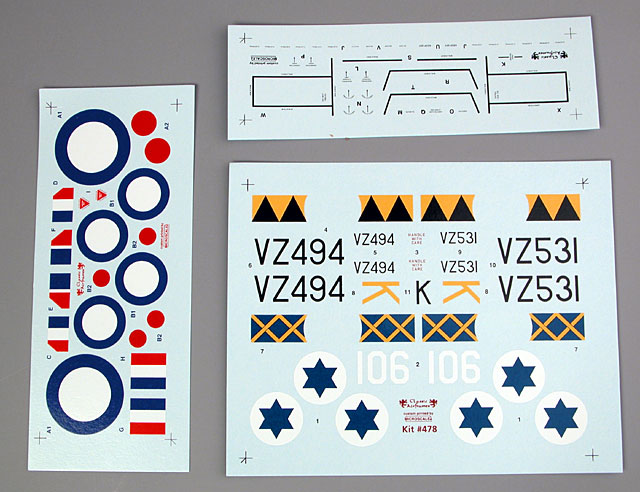
Options include the distinctive belly tank and
wing-mounted drop tanks.
Strangely, the kit does not supply a gunsight, so you will
want to scratchbuild one from scrap plastic or, alternatively, buy a resin
after-market item. Also, the style of wheels seems to be more appropriate
for the early Meteors. Even so, the main wheels are barely visible under
the nacelles.
Classic Airframes latest recent releases have been a joy to behold in
the box, and the Meteor F.8 is no exception.
The lack of locating pins will call for extra care and dry-fitting; and
a little more cleanup than average will be required; but I do not see
anything too alarming in construction.
HyperScale has already heard from two modellers who have built this new
Meteor and, although there are some challenges presented
(especially aligning the intakes and in the location of the cockpit and
the nose wheel bulkhead), the model does appear to be eminently buildable.
The Hannants "Special Edition" certainly delivers the greatest
flexibility of all the boxings, with the option of the two different
canopies included as well as the alternate intakes. It is also nice to
already see after-market decals from Xtradecals. I hope that resin
manufacturers jump on the bandwagon too, with a set of rockets.
Classic Airframes' 1/48 scale Meteor F. Mk.8 looks like a good prospect
for a modeller who feels ready to tackle something slightly more
challenging than a standard Tamiya or Hasegawa offering.
Highly Recommended to experienced modellers.
Thanks to David at
Hannants for the review sample.
Review and Images Copyright © 2003 by
Brett Green
Page Created 06 October, 2003
Last updated 06 October, 2003
Back to HyperScale Main Page
|
Home | What's
New | Features
| Gallery |
Reviews | Reference
| Forum
| Search